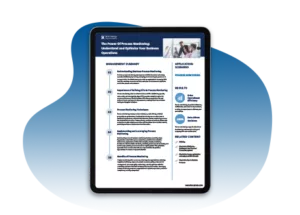Introduction
Crafting compelling blog posts without resorting to clichés can be a challenge, especially when it comes to strategy-focused content. Many articles begin with a predictable quote from Sun Tzu, emphasizing the fusion of strategy and tactics. However, in our case, we’re not engaging in a battle; instead, we’re dedicated to optimizing your Business Process Management Strategy (BPM) with a clear vision.
If you’ve recently delved into our comprehensive guide of Business Process Management, you’ve already learned about the Process Management Lifecycle and its cornerstone, the BPM Strategy. It’s important to recognize that the BPM strategy is not a standalone entity; rather, it’s intricately intertwines with the organization’s overarching strategy. The strategic goals and objectives set by the organization serve as the guiding compass, while the BPM strategy provides the roadmap for executing and attaining those goals efficiently. By aligning BPM initiatives with the broader organizational strategy, companies can leverage their process capabilities to fuel sustainable growth, adapt to evolving market dynamics, and gain a competitive edge.
In this blog post, we will delve into the crucial link between BPM strategy and organizational strategy, exploring how they mutually influence each other and drive success in today’s dynamic business landscape.
How to define a Business Process Management strategy?
Implementing strategic decisions begins with being clear about the strategy’s goals, the methods for achieving them, and how to measure success. Organizational goals represent overarching aspirations and outcomes that are linked to the mission and vision. Defining goals is challenging, especially during a mature organizational transformation. A thorough analysis of the mission, vision and values is critical, as is identifying the long-term desired impact.
At its core, a BPM strategy focuses on aligning business processes with the company’s goals, customer needs and market requirements. To achieve this, it is important to set SMART (specific, measurable, achievable, relevant, and time-bound) goals that are realistic, yet ambitious and flexible, and to involve key stakeholders, especially senior leadership.
Once goals are defined, they should be broken down into specific outcomes for tangible targets. KPIs that are quantifiably linked to the goals with measurable benchmarks are essential for evaluating progress and end results. Ultimately, these KPIs need to be regularly reviewed and updated based on evolving business needs.
How to execute a Business Process Management strategy?
Implementing a BPM strategy takes a systematic and structured 5-step approach to analysing existing processes, identifying opportunities for improvement, redesigning processes, implementing changes, and monitoring results, as described below.
1. Analysis of the existing processes
To set concrete and measurable goals with appropriate metrics, an analysis of the current state is essential. This analysis uncovers valuable opportunities for improvement. A careful assessment of the company’s existing processes can identify strengths, weaknesses and untapped potential. This examination uncovers inefficiencies, bottlenecks and areas for growth. These findings form the basis for setting clear targets and key performance indicators (KPIs).
2. Identifying areas for improvement
Through a thorough examination of processes, companies can uncover inefficiencies, bottlenecks and areas of untapped potential. By leveraging these insights, specific areas are identified where changes and optimization can be made to align with the strategic direction of the business. This targeted approach enables the definition of measurable goals that directly target the identified improvement opportunities. This creates a clear path to success and ensures that efforts are focused on achieving tangible results and creating value for the business.
3. Process optimization
Process optimization, an important aspect of any BPM strategy, then involves as a next step the redesign of the previously selected processes to improve their efficiency, effectiveness and overall performance. It aims to eliminate bottlenecks, reduce redundancies and simplify complex workflows. By optimizing processes, companies can increase productivity, reduce costs, and achieve better results, ultimately leading to higher customer satisfaction and a competitive advantage in the marketplace.
4. Implementation and change management
Implementing BPM strategy involves making process changes and managing their adoption. Communication, stakeholder engagement, and training are key to smooth transitions. Addressing concerns, providing resources, and encouraging support promote adoption. Change management practices, such as assessing the impact of changes and regularly monitoring progress, minimize resistance and align changes with strategic goals.
5. Monitoring outcomes
Tracking progress and measuring the achievement of these goals is facilitated by defining relevant KPIs. Regularly reviewing and updating KPIs based on evolving business needs ensures that our strategy remains agile and adaptable. Through a comprehensive analysis of existing processes, organizations can prioritize improvement actions, set realistic targets, and steer the course of strategy implementation toward effective outcomes.
BPM methods & technologies to support your BPM strategy
Selecting the right process documentation approach
To make this 5-step approach practical and easy to manage, we recommend creating appropriate process documentation that provides a comprehensive overview of your organizational processes and allows you to better track changes as the transformation progresses.
Hint: Read our comprehensive process documentation guide if you would like to learn more about this topic.
In this context, choosing the right documentation approach is critical for the overall success of our BPM strategy. When making this decision, consider your organization’s individual needs, goals, and existing processes, as well as factors such as process complexity and corporate culture. Assess strengths, limitations, and compatibility, and consider their compatibility with the organization’s goals and resources. The choice of an appropriate notation system, such as BPMN, text-based documentation, or UML activity diagrams, depends on the level of clarity and understandability required for the target audience.
To start, you can decide between two common documentation approaches: top-down and bottom-up . Top-down starts with a high-level perspective such as process landscapes to gain an overview, mapping interconnected processes and their alignment with objectives. Bottom-up begins with detailed modelling of activities, gradually building the process portfolio.
Example of a process landscape model in the BPM Suite ADONIS
Ultimately, the choice between top-down and bottom-up approaches depends on the organization’s priorities, the level of process maturity, and the intended use of the documentation. Top-down identifies areas for improvement, dependencies, and goal alignment, while bottom-up offers a more detailed understanding, enabling targeted improvements. In some cases, a combination of both approaches may be appropriate, enabling a comprehensive understanding of processes while maintaining a focus on strategic alignment and operational effectiveness.
Example of a process model in the BPM Suite ADONIS
By carefully considering the method, notation, and documentation approach, organizations establish a foundation for effective process management and successful implementation of the BPM framework.
Hint: To learn more about process landscapes, watch our free webinar “Process Maps: Key Tool for Optimization of Business Processes“
Adopting BPM software and satellite technologies
Another essential strategic decision in the context of the BPM strategy is the selection of a suitable software tool for documenting and managing business processes, as it has a direct impact on the success and results of the overall strategy implementation. BPM software provides a central platform for capturing process knowledge, creating process models using standardized notations such as BPMN, and documenting detailed process information. Such tools enable organizations to effectively visualize, analyze and communicate their processes, fostering a shared understanding among stakeholders and driving process improvement initiatives.
Other technologies, such as workflow automation and enterprise resource planning (ERP) integration, play an important role in implementing the BPM strategy. Process Automation streamlines processes, shortens cycle times and improves performance. Integrating BPM with ERP systems enables seamless data exchange, ensuring data consistency and providing a holistic view of end-to-end processes across the enterprise.
While BPM software and satellite technologies bring many benefits, their adoption needs to be thoroughly considered. Evaluate costs (licensing, implementation, maintenance), consider the learning curve and compatibility with legacy systems. As you make your strategic decision, weigh the benefits against the costs and challenges by conducting a comprehensive cost-benefit analysis that considers ROI, sustainability, and alignment.
Nonetheless, a software tool is critical to BPM success. It enables effective process documentation, analysis and optimization. Integration with satellite technologies can further increase synergies and optimize efficiency, automation and alignment with strategic goals.
Hint: Watch our free webinar “Key Criteria when selecting a BPM tool” to get insights into key criteria when choosing a suitable BPM suite.
Summary
A solid BPM strategy, supported by software and technology, is essential for business success. It aligns processes with strategic goals and leverages advanced tools to optimize efficiency, improve performance, and enhance the customer experience. BPM software enables effective process documentation, analysis and optimization, driving operational excellence and continuous improvement. The use of these tools is essential for sustainable growth and competitive advantage in today’s dynamic business landscape.
A BPM Suite, like our Gartner customers’ choice ADONIS, enables detailed process documentation, analysis and informed decision making. The industry-proven tool provides a comprehensive solution for continuous improvement and an easy-to-use interface for users at all levels. Explore ADONIS for free with the ADONIS:Community and start building your BPM strategy today!
Related BPM Resources:
Get our weekly updates.
Never miss the freshest content.













